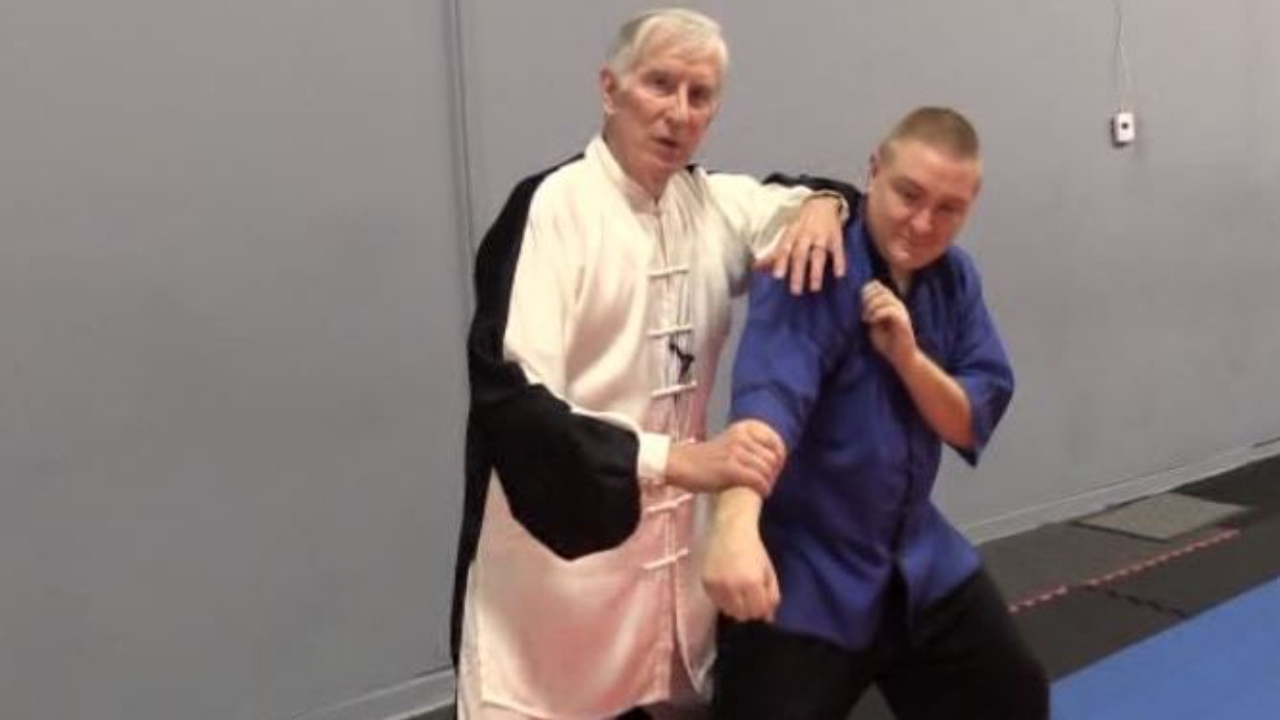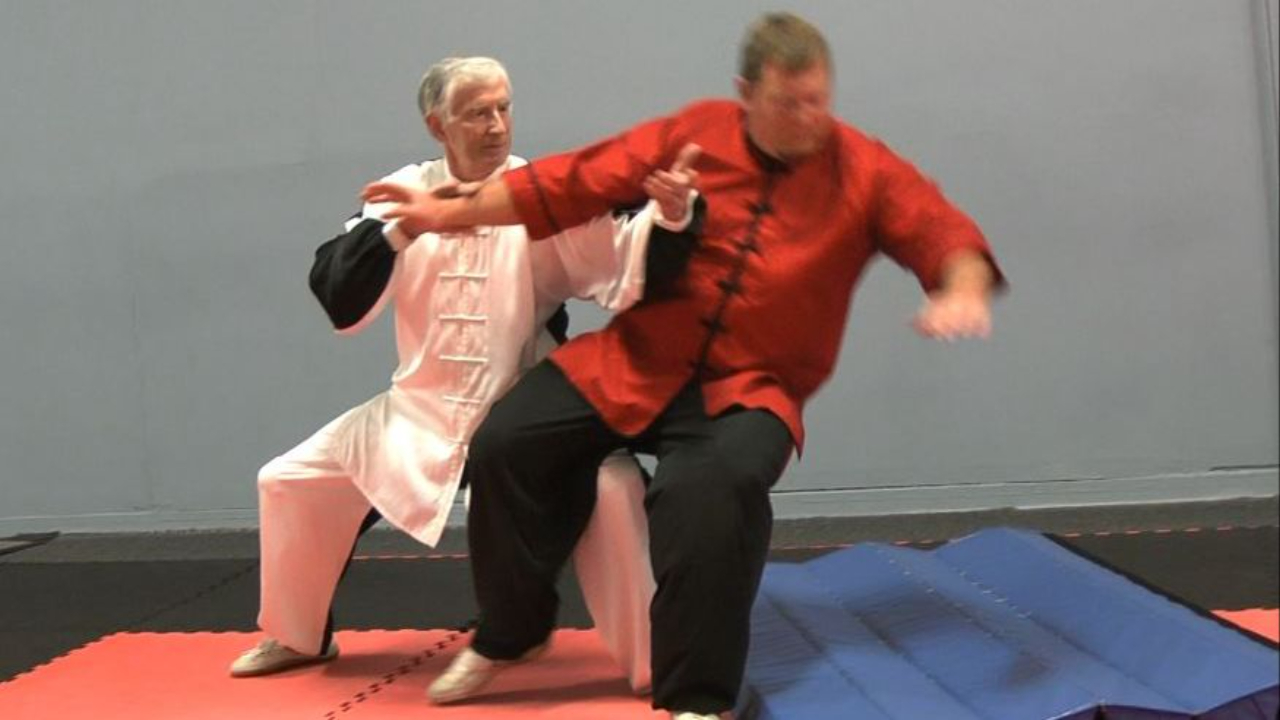Tai Chi Ebook - Self-Defense Using the Chen 19 Form

I have written an ebook with 239 photos and detailed instruction for 106 self-defense applications that are found in the short Chen Taiji 19 Form. The ebook is titled Chen Taiji Self-Defense - Fighting Applications from the Chen Family Tai Chi 19 Form. It is available on the Amazon Kindle store for $4.99 and will play on any device with the free Kindle app installed.
The Chen 19 Form was designed by Chen Xiaowang in 1995. He was asked by students around the world for a shorter form to fit into their busy daily lives. Also, in my opinion, I believe he wanted to provide a Chen family answer to the Simplified Yang 24 Form that has become the most popular Tai Chi form in the world.
The Chen 19 Form takes about 5 to 6 minutes to perform if done slowly -- less time if you do it with power and speed. It is based primarily on the longer form, Laojia Yilu. Movements are a bit conservative, with less obvious silk-reeling, than the Chen 38 or Xinjia forms. This is the first form that I teach...
Press Energy and One of Its Meanings

When I first studied Tai Chi, I learned about Ward Off (Peng), Roll Back (Lu), Press (Gi, pronounced "jee"), and Push (An, pronounced "On").
We were told there are eight primary "energies" in Tai Chi.
On the rare times we did fighting applications, we thought of Press as a pressing outward type of movement, as in the top photo on the left.
But Press has a different quality. With this "energy," you crowd your opponent. One way this is done in Bagua and Taiji is to deflect incoming force and position yourself close enough to your opponent
that he is unable to defend. At this point, you are set up to do what you need to do.
In the middle photo, I am doing a movement from the Bagua Swimming Body form called "Black Dragon Slashes Its Tail." My partner has punched and I have moved in as the punch was deflected. I am now close enough to do a palm strike, a shoulder bump, a leg technique, and more.
In Taiji you can do this while pushing hands, too. During the double hand routines...
Tai Chi Self-Defense - There Are No Transitions in Tai Chi

When I was first learning Tai Chi, the word "transition" was used often. Holding the Ball was a transition into Part the Wild Horse's Mane. Circling the arms was a transition for Brush Knee Step Forward. After changing teachers and styles, I learned a simple truth:
There are no transitions in Tai Chi.
As I later learned, a self-defense application is built into every movement in Tai Chi. Every movement.
No matter where your hands and feet are, a fighting application is there.
Here is a case in point, one of 108 self-defense applications demonstrated through 259 photos in my new ebook, Yang Tai Chi 24 Form Self Defense. The ebook is only $4.99 through Amazon Kindle -- a great reference for those who practice Yang style Tai Chi, particularly the 24 Form.
Let's say that someone comes up behind you and grabs your shoulder, preparing to punch your lights out. Now, this could even be done from a clinch position or against a punch, but I'm showing this particular set-up as a way to d...
Fun with Tai Chi Self-Defense - Single Whip

This is a video I shot in 2008 showing some fighting applications for the Tai Chi movement "Single Whip." It's an example of the kind of instruction you'll find on my website.
Martial Artists - Are You Making This Mistake with Your Body Mechanics?

Martial artists with any experience at all believe they're generating a lot of power with their movements. In my first kung-fu class as a student--way back in September, 1973--we stood and punched, snapping our hips with the punch to add power to the technique.
As I've studied and taught the internal arts, I had to learn body mechanics that are very different from the other kung-fu, taekwondo, and boxing instruction I had received in the past.
A little over a week ago, I held a workshop for all martial artists on the fighting applications of the Chen Tai Chi 38 form. Attendees included students and teachers from a wide variety of arts, from Shaolin and taekwondo to a Yang style teacher. There were white belt students and very high-ranking black belts.
And almost every one of them made one mistake. I knew they would, because everywhere I go--every martial artist I meet--makes this mistake.
Their movements are not connected from the ground through the body.
Here are some photos ...
Tai Chi Self-Defense Workshop was a Lot of Fun

At least 17 people showed up for my workshop yesterday at John Morrow's Academy in downtown Moline, Illinois. Martial artists from all styles were there -- TKD, karate, another tai chi instructor (Yang style), Shaolin students -- it was a great group of very nice people.
Two members of the online school drove in from Dixon, Illinois and another member, Wally, drove in from Chicago.
We went over fighting applications from the Chen 38 form. Each of the participants will receive a DVD -- Nancy videotaped it for the Chen 38 DVD that's due out in the next two weeks.
I knew I was going to enjoy showing internal body mechanics to a variety of martial artists. It was a blast showing them fighting applications from tai chi, and the relaxed power you can generate from the proper body mechanics.
One of the hallmarks of "external" styles is the twisting of the hips. Many martial artists twist their hips too much when they move, and they kink their posture and put themselves into vulnerable po...
A Sneaky Technique for Unbalancing an Attacker

On Saturday, we practiced various techniques for unbalancing an attacker. Some were very subtle and will be covered in future posts and videos.
Here's the concept -- you take your opponent in the direction he wants to go. You can help the process along by making slight adjustments and adapting to the way he moves so that you can take advantage of they way he is moving.
Sometimes it only takes a push on his calf with your shin to make his rear shoulder turn every so slightly -- but enough for you to grab and help the shoulder continue moving in that direction, causing your attacker to lose balance even more and hit the ground.
In the photos here, Leander Mohs is attacking Chris Miller. You see him step in with a punch. Chris deflects the punch and puts his right foot behind Leander's left foot and slides it back toward him. This unexpected move causes Leander to lose balance and he turns, trying not to fall on his back. The result puts him in a vulnerable position and Chris c...
Fun with Tai Chi Applications - Closing the Form

I'm almost finished editing the final DVD in the series on fighting applications of Laojia Yilu. There should be about 400 applications in the 3-DVD set -- a pretty amazing number for one form. There are supposed to be more than 600 but I didn't repeat any movements.
Taking the time to study the movements for this DVD series was a great learning experience for me. I've always felt that you learn a lot in class but you learn the most by quiet, thoughtful practice and study on your own. That's certainly true in this instance.
I've included three photos in this post showing an application from the final movement in the form -- Closing the Form -- movement number 75. You are being choked. You snake your arm under the opponent's armpit, turn the body and "close." The energy in your hands is downward energy, the same as in the very first movement of the form.
In an actual self-defense situation, you would naturally put fajin into the movement and do some damage. If you look at the thir...
Tai Chi Fighting Applications -- When Is A Punch Not A Punch?

I'm editing the third DVD in the series on Laojia Yilu fighting applications. This important Chen tai chi form has 75 movements--many of them repeated more than once--and the DVD series takes a look at each movement (without repeating them) and uncovers around 400 fighting applications.
As I edit this third DVD--the final one in the series on Laojia Yilu--I'm putting each movement and its applications on the online school for members to see first.
The DVD starts with movement 33 in Laojia Yilu -- Punch the Ground. Within the first three movements--Punch the Ground, Turn Body Round and Double Kick, and Protect the Heart Fist--there are 30 fighting applications demonstrated.
The photo here shows my favorite application of Punch the Ground--a throw. When is a punch not a punch? When you snake your arm under your opponent's armpit, turn, and punch the ground.
I'm having a lot of fun with this series. I shot the video before moving from Tampa (I really miss that weather since we have ...
Internalizing Fighting Applications for Tai Chi, Xingyi, and Bagua

Working on forms is one of the foundations of a good martial art. Forms teach many things, including proper body mechanics, posture, balance and precision.
I once read a tai chi article by a guy who said if you practice the slow Yang form for 20 years, you'll be able to fight when a self defense situation arises.
No you won't. You'll be seriously injured or killed. That's what will happen.
If your practice is only on form, you're missing the heart of any internal art, which is self-defense. You must practice fighting applications in a way that helps you internalize them so that you can react without thinking.
Sparring is one way to do it, but let's face it. Sparring the tournament way limits your techniques. And you can't really use all the techniques of these arts against classmates because you can't drive your palm through their faces, break their elbows and wrists, dislocate their shoulders, twist their necks until they snap, throw them to the ground to smash their head, etc.
H...
